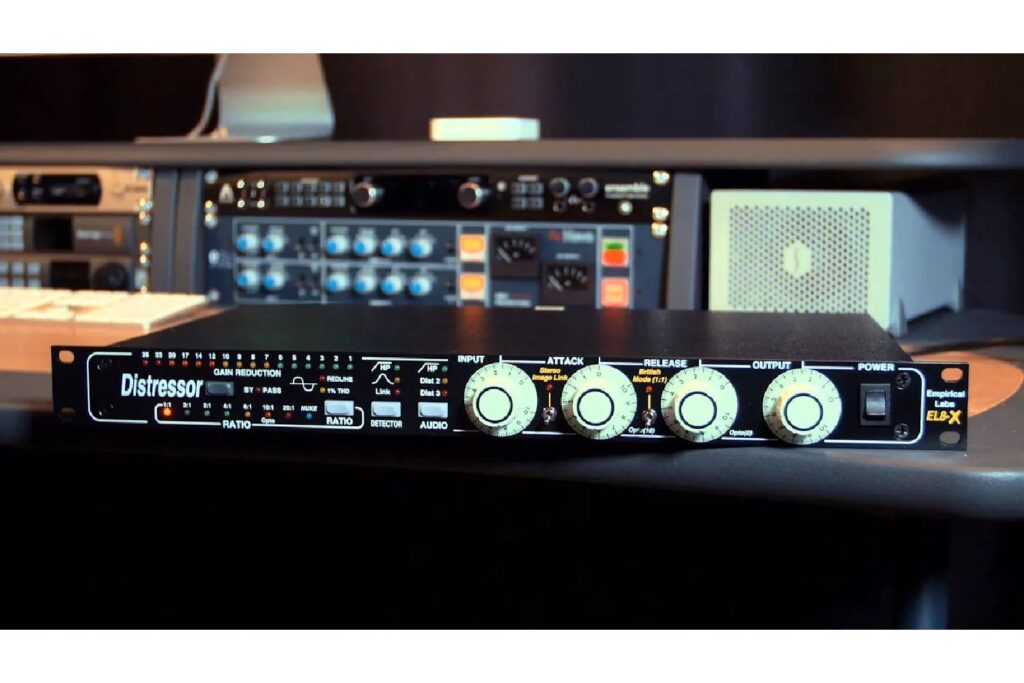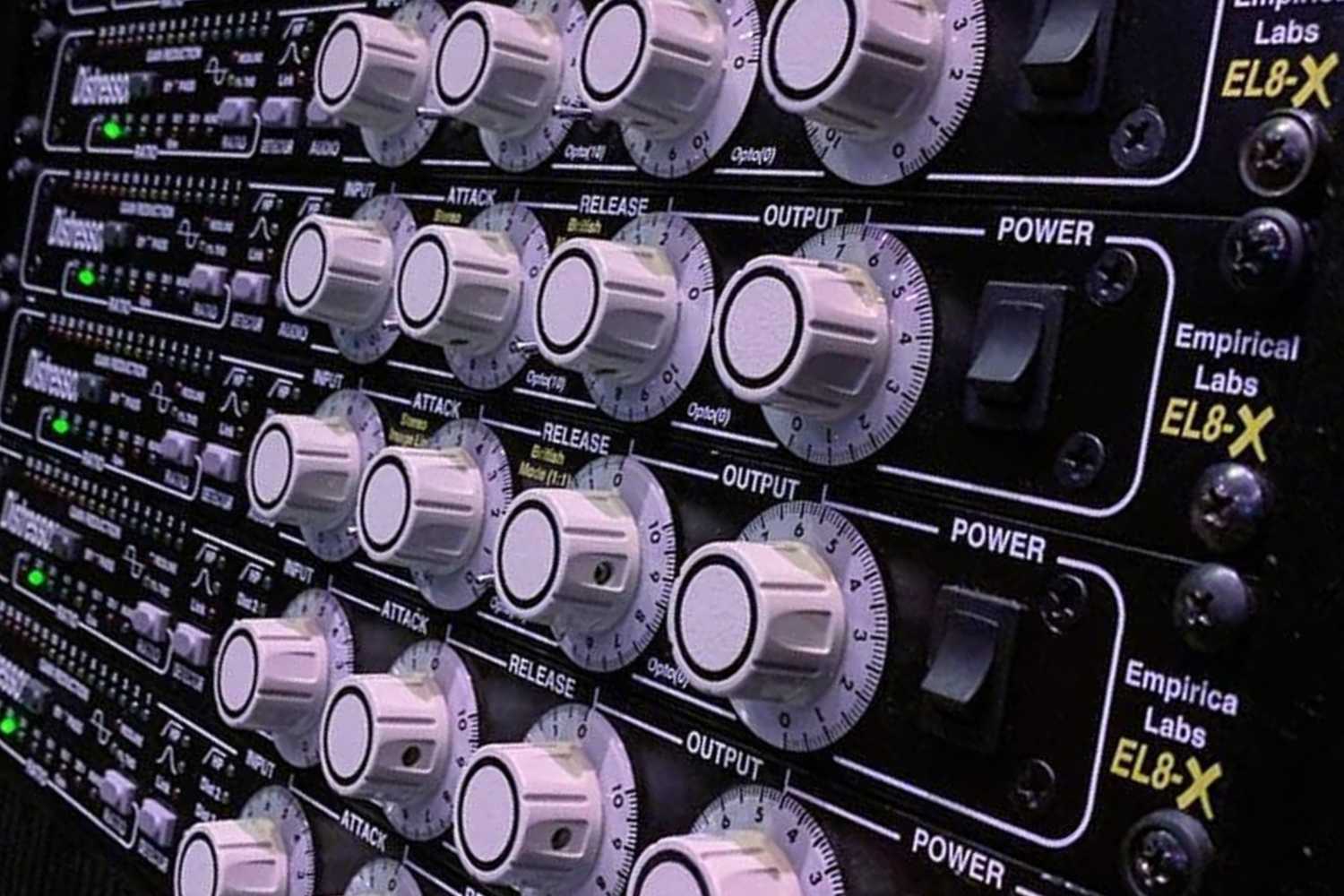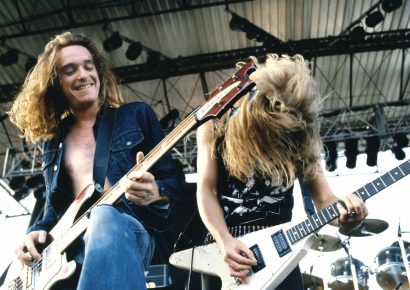Over the past 25 or so years, there have been a select few pieces of pro audio gear that have truly stamped their mark on the process of record making.
There would be few to argue the point that the Empirical Labs Distressor well and truly holds its own in this distinguished category of gear, and it would be hard to dispute it being the front runner for defining the term “modern classic” and more to the point of this article – a gear icon.
Distressor
Coming up playing in bands in the 80’s, Dave Derr (Empirical Labs founder and masterful creator of the Distressor) had an early love and appreciation of compression, impacted by the sound and feel it imparted on his own music when touring and playing live. Realising his passion for the technical elements of audio and quickly cramming his head into electronics and circuit design books, Dave landed an audio technician gig with pioneering digital audio heavy weights Eventide. Having developed the analogue converts for the now iconic H3000 Harmoniser (as you do), Dave’s experience with the tight knit team at Eventide helped develop a deeper knowledge and skill set of circuit design – and having the tools at his disposal to be able to take apart and measure various pieces of equipment from his own studio, this fast tracked the development of his own circuit designs.
Read up on all the latest features and columns here.
From first inception, the Distressor seemed inspired by a clear vision. Aside from making a compressor that was both versatile and reproducible, the Distressor needed to encompass some of the fabled characteristics of favoured pieces from Dave’s own studio. Fascinated by the unique sonic character that the Universal Audio 1176 LN, LA-2A and Valley People Gain Brain compressors imparted upon audio that passed through them, these distinct harmonic flavours and saturation qualities gave an intangible level of depth, character and vibe to an overall mix, which in turn were uniquely incorporated into the design. After scrupulous testing, measuring of the aforementioned vintage compressors, tireless tinkering and testing (which often involved breadboard circuits tucked behind other equipment during tracking and mixing sessions), the Distressor was finally realised. From the numerous prototypes through to the fully formed 1U piece as we know today, Dave starting humbly making these units himself one by one, and by the mid 90’s (with a little marketing magic from Gil Griffith and a handful of orders from some of the biggest names in audio at the time), the Distressor was the new hot product in pro audio.
There are of course numerous elements of the Distressor that make it such a modern classic. Far from a one trick pony and more like a mystical unicorn, the Distressor’s ability to wrangle audio whether tracking or mixing is seemingly endless. Being a digitally controlled piece of analogue gear gives it a distinct advantage for precise control and dialling specific settings. Aside from their unmistakable aesthetic, the four front panel knobs of the Distressor are meticulously designed for accuracy and feel. Being inspired by the robust tactility of vintage units (a la the controls of the 1176 LN or LA-2A), their larger size helps with the ability to dial (and recall) specific settings of Input, Output, Attack and Release with unprecedented speed and accuracy. These dials have become so important and synonymous to the Distressor, they are patented and trademarked.
Distressor compressor
Versatile is a bit of an understatement when it comes to the Distressor, with a total of 8 switchable ratios alone, each presenting unique curves and interaction with source material. This is particularly prevalent as the knee and the respective threshold of each ratio changes, which dramatically changes with relation to where the input is set of course. This paired with the precise control over attack (50 microseconds – 30 milliseconds) and release (.05 secs – 3.5 secs and up to 20secs in 10:1 Opto mode) allows the Distressor to go from literally zero compression (1:1 ratio – more on this in a sec), lightly controlled 1-3dB of gain reduction right the way through to brick wall limiting in the legendary NUKE mode – with off the scale gain reduction (more than 26dB from the gain reduction LED meter) still somehow sounding musical and usable.

Aside from being a wildly versatile compressor/limiter, the Distressor’s ability to dial in a variety of characterful saturation, harmonics and distortion is a unique part of its sonic arsenal. This paired with its remarkably customisable detector section is what makes the Distressor a standout piece of gear. The detector section allows for an unprecedented level of control over what the compressor sees and is inevitably going to compress. The high pass filter (or HP) allows for low end energy of a signal to pass through uncompressed, reducing undesired pumping or noticeable dipping, such as a P or B burst from a vocal, or allowing the sub energy from a kick drum or bass guitar room to breath, without unnecessarily triggering the compressor.
In addition to the HP, the switchable band emphasis switch focuses the compressor detector to only compress in the upper midrange starting from around 3kHz. This gives a unique level of control over potential harshness of a sound source like the upper register of a vocal, guitar or even cymbals from overheads.
Finally, the LINK button both allows for linking of two Distressors together making a stereo unit, but more interestingly can be engaged on a single unit which feeds the AUDIO section in a unique way, creating more extreme distortion and harmonic characteristics – as this section is expecting to receive more level from a stereo source – very cool indeed! Any one of these buttons can be engaged individually or in any combination of the three to create a near endless variety of behaviour over the compressor circuit and how it responds.
The AUDIO section of the Distressor can sculpt sounds with any level of compression from none when in 1:1 ratio or fully pulverised in NUKE mode. The selectable audio circuit includes a high pass filter (HP and separate from the detector), which is a gentle Bessel filter rolling off 80Hz and below, which is superb for treating a vocal or other such instrument where some sub roll-off is required. The two distortion switches is where the Distressor comes into its own though, with the Dist 2 circuit creating some 2nd (a.k.a. even) order harmonics, reminiscent of classic Class A and/or Tube like harmonic character. Dist 3 has an emphasis on third order (a.k.a. odd) harmonics with a top and bottom roll-off and distortion character much like a tape machine. This distinct flavour of saturation can be more or less dramatic depending on attack and release settings, how much gain reduction is applied and whether the LINK button in the detector is engaged. This section alone is pure magic and particularly fun if used in the EL8X version of the Distressor in Brit Mode – which emulates the all buttons in mode of the 1176 LN – the ultimate bombastic experience.
Distressor plugin
It’s important to note that while the hardware units are the classic design, Empirical Labs themselves have unveiled a plugin version: the Arouser!
I wanted to finish with a few settings on the Distressor (courtesy of the Distressor manual and my own personal experiences) that land well within the realms of 1176 LN and LA-2A style flavouring, as well as some downright explosive fun! For some 1176 LN like flavour, selecting 3:1, 4:1, 6:1 and 20:1 ratios and keeping the attack time below 4 gives that distinctly fast attack and upfront-ness that these units are known for. For a more Opto-VCA style feel such as an LA-2A, the specific OPTO setting on the 10:1 ratio with an attack time of 10, release set to zero 0 and HP on the detector engaged ooze that optical vibe, plus experimenting with the Dist 2 or Dist 3 settings can introduce some tube-like harmonics. A personal favourite setting whilst tracking is when inserted over a snare, with attack set between 4-6, release 1-3 aiming for an average of 3-4dB of gain reduction, with HP engaged on both the detector and Audio sections as well as Dist 2 switched in. This gives a nice little crunch and harmonic saturation to a snare straight off the bat, and something typically done whilst mixing anyway – so why not commit from the get go.
Also using the Distressor in NUKE mode in parallel with drums or for downright crushing can be particularly enjoyable, adding an explosive energy and with the right release dialled in can also lengthen the sound transient heavy sound sources.
The continued success of the Distressor since its release in 1996 really does speak for itself, with over 38,000 units reported in the field and growing. Its reproducibility from a manufacturing stand point has given it a distinct edge, with each unit meticulously tested and calibrated before shipping, through to its hand picked and tested components – the Distressor truly does stand amongst the giants in pro audio outboard devices. Its tactile, intuitive layout and ability to recall setting with lighting fast speed and precision have afforded it to be a go-to favourite for commercial and home studios alike. A mainstay in pro audio circles, the Distressor is sure to outlive us all.
For local Empirical Labs enquiries, visit Gsus4.

